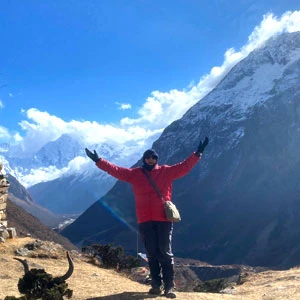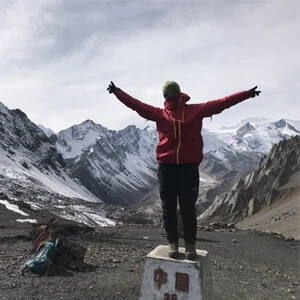Everest Three High Passes Trek Overview
If you are looking for the ultimate trekking adventure in the Everest region, the Everest Three High Passes Trek is as epic as it gets. During this trekking adventure, you will be crossing three of the highest and most iconic passes in Nepal: Kongma La (5,535 meters), Cho La (5,420 meters), and Renjo La (5,340 meters). Along the way, you will be surrounded by some of the tallest peaks on the planet, including Everest, Lhotse, Makalu, and Cho Oyu, with panoramas so surreal they almost don’t look real.
Your journey kicks off with a thrilling flight to Lukla, often called one of the most exciting flights in the world. From there, you will follow the Dudh Koshi River, cross hanging suspension bridges, and trek through pine and rhododendron forests before reaching Namche Bazaar, the lively Sherpa hub of the Khumbu. Namche is where tradition meets trekking: you will notice yaks grazing nearby, mountaineering guides swapping stories over tea, and if you are here on Saturday, you will get to enjoy the local market filled with everything from Tibetan handicrafts to fresh produce.
As you head higher, the cultural flavor only gets stronger. At Tengboche, you will find Khumbu’s largest monastery with spellbinding views of Ama Dablam. Villages like Dingboche and Chhukung offer acclimatization opportunities, with side hikes to Chhukung Ri rewarding you with jaw-dropping views of Makalu, Lhotse, Island Peak, Ama Dablam, Barunche, Khangtega, and Pumori. Then comes your first big challenge: Kongma La Pass (5,535 meters), a tough ascent across rugged trails and glacier ridges, with the vast Khumbu Glacier unfolding beneath you.
After your first pass, you will head towards the Everest Base Camp (5,364 meters) and next morning hike to one of the most famous and rewarding viewpoints in the Everest region, Kala Patthar (5,550 meters). From here, the mountain views hit a whole new level as you will see Everest so close you will feel you can touch it. Alongside Everest, you will also notice Pumori, Nuptse, Lobuche Peak, Ama Dablam, Cholatse, Tabuche, and many more. The next big milestone is Cho La Pass, a steep and icy crossing that drops you toward Dragnag and eventually the jewel of the trek: Gokyo Lakes. These turquoise glacial lakes are among the most beautiful alpine settings in Nepal. While in Gokyo, you will climb up Gokyo Ri (5,483 meters), which will give you arguably the best panorama in the entire Himalaya, with Everest, Lhotse, Nuptse, Cho Oyu, and Makalu all in one sweeping view.
Lastly, the final challenge of the Everest Three High Passes Trek in Nepal is the Renjo La Pass (5,340 meters). It ties the adventure together with one more knockout Himalayan vista before you descend toward Lumde and loop back to Namche and Lukla. Along the way, you will be welcomed into warm Sherpa communities, learn about Tibetan Buddhist traditions, and get glimpses of their daily lifestyle.
The Sherpas are the major ethnic group here, and if you spend some time chatting with them, you will notice how multilingual they are. Many Sherpas who work in trekking and mountaineering can switch between Tibetan, Nepali, and English with ease. They follow Tibetan Buddhism, which you will see reflected everywhere, in prayer flags, mani stones carved with mantras, and of course, in their grand religious festivals.
Their biggest festival is Lhosar, or more specifically Gyalpo Lhosar in the Sherpa tradition. Falling around February or March, it marks the Tibetan New Year. During Lhosar, Sherpa families gather for dumpling feasts called guthunk and wash them down with chhyang, a Tibetan-style beer.
Similarly, in mid-October to mid-November, the Mani Rimdu festival takes center stage at Tengboche Monastery, with Ama Dablam’s peak as the backdrop. This is one of the most iconic festivals you could witness while trekking to Everest in October. You will see monks in vibrant, elaborate costumes perform sacred dances symbolizing the triumph of good over evil.
Other important celebrations include Dumji, which usually happens in June or July. Dumji is a community festival celebrated across Sherpa villages to honor Guru Rinpoche (Padmasambhava), the saint who spread Buddhism across the Himalayas. Then there’s Saga Dawa, falling in May or June, which is one of the most sacred Buddhist observances. It commemorates the birth, enlightenment, and death of Lord Buddha all in one month. If you are trekking during Saga Dawa, you will notice locals lighting butter lamps, spinning prayer wheels, and joining processions.
And of course, Buddha Jayanti, the day of Buddha’s birth, falls in April or May. Across the Everest region, monasteries like Tengboche, Pangboche, and Thame hold ceremonies filled with butter lamps, chants, and prayer ceremonies.
All in all, if you happen to be trekking to Gokyo during Janai Purnima, which usually falls in August, you are in for a special experience. At Gokyo Lake, local pilgrims and trekkers gather to bathe in the icy waters, believing it cleanses sins and brings blessings. The atmosphere is festive yet spiritual, with rituals, offerings, and a mix of locals and adventurous trekkers sharing the same sacred space.
Wildlife & Views
One of the most underrated parts of the Everest Three High Passes Trek in Nepal is the living, breathing world around you. Since most of the trail lies within Sagarmatha National Park, a UNESCO World Heritage Site, you will be walking through a protected sanctuary that holds both rare Himalayan wildlife and some of the most jaw-dropping landscapes on Earth.
The park covers a huge altitude range, which means the ecosystem changes dramatically as you climb higher. Below 3,500 meters, you will trek through pine and fir forests, clusters of bamboo, and rhododendrons, the national flower of Nepal, which turns the hillsides into a fiery red and pink show in Spring. As you push higher into the alpine zone above 4,000 meters, the scenery shifts to hardy juniper shrubs, moss-covered rocks, dwarf rhododendrons, and tiny alpine flowers clinging to the slopes.
And then comes the wildlife. If you are lucky, you might spot the Himalayan Tahr or herds of blue sheep (bharal) grazing in alpine meadows. You may also see musk deer, griffon vultures, lammergeiers, and Himalayan Monal, and Danphe (Nepal’s national bird). Of course, the ultimate prize here is the elusive snow leopard or the rare red panda in the lower forested areas. Pro tip: your best chances of seeing wildlife are in the early mornings or late afternoons when the trails are quieter.
Apart from wildlife, every high pass comes with its own reward. From Kongma La, you will get vast panoramas of the Khumbu Glacier and surrounding giants, Cho La will offer icy terrain and commanding views of Ama Dablam and Cholatse, and Renjo La feels like a 360° postcard with Everest, Makalu, Rolwaling, and Gyachung Kang. Beyond the passes, you will constantly be walking beneath legends: Everest (8,848 meters), Lhotse (8,516 meters), Makalu (8,481 meters), Cho Oyu (8,188 meters), and if you are into details, also peaks like Ama Dablam, Pumori, and Thamserku.
What Makes The Combined Trek To Everest Three High Passes With Gokyo Lake & Everest Base Camp Special?
Three Major High Passes (Kongma La Pass, Cho La Pass, & Renjo La Pass)
The Everest Three High Passes Trek in Nepal is all about conquering its trio of legendary crossings: Kongma La (5,535 meters), Cho La (5,420 meters), and Renjo La (5,360 meters). Each pass delivers its own challenge with steep ascents, icy trails, and thin air, but the payoff is unmatched panoramas of Everest, Lhotse, Makalu, and Ama Dablam.
Kongma La Pass (5,535 meters)
Kongma La Pass is the first and highest of the Three Passes Trek in Nepal. At 5,535 meters, this rugged gateway connects Chhukung to Lobuche, offering you both a serious physical challenge and jaw-dropping Himalayan rewards. The trail starts out of Chhukung with a gradual climb, but soon enough it turns into a steep, rocky ground with scree underfoot and cairns guiding the way. Near the summit, the path almost disappears into ridges and broken stones, so it feels like you are carving your own route through the mountains. Depending on the season, you might even find patches of snow and ice; hence, it is important to carry trekking poles and even crampons.
Standing at the top of the Kongma La Pass, you will witness Everest, Lhotse, Nuptse, Makalu, Ama Dablam, Island Peak, Lobuche, and Pumori, with the massive Khumbu Glacier stretching out below. During your descent toward Lobuche, you will be navigating down rocky trails and across glacial terrain.
During this climb, you will notice thin air, steep switchbacks, and rugged ground. All in all, it is one of the most rewarding crossings in the Khumbu. You must trek Kongma La Pass during Spring or Autumn for the best conditions, since snow can shift the difficulty level in a heartbeat. Altogether, wildlife is rare up here, though you might spot yak caravans lower down as you descend.
Cho La Pass (5,420 meters)
Cho La Pass is the one that really tests your grit on the Everest Three Passes Trek. At 5,420 meters, it’s a mix of steep climbs, glacial crossings, and rocky scrambles that connect Dzongla to Dragnag, essentially bridging the classic Everest Base Camp trail with the magical Gokyo Valley. The path itself feels like an obstacle course with loose rocks, glacial moraines, and a slippery ice section. During Winter and at times in early Spring, this pass hides under snow and ice, and even in peak trekking seasons, you may find icy patches that demand slow, deliberate steps.
But here’s the reward: when you finally crest the top, the Himalayas hit you with a view that feels otherworldly. To the west, you will witness Gokyo Lakes sparkle in surreal turquoise, while giants like Cho Oyu, Lhotse, Makalu, and even Everest’s ridges dominate the horizon. Moving on, the descent is quite steep and knee-testing.
Altogether, to cross the Cho La Pass, you need to be well-acclimatized, fit, and mentally ready for a long, demanding day. Here, layered clothing is a must because the weather can flip from calm skies to biting cold in minutes. You won’t see much wildlife up this high (just the occasional hardy alpine moss or a Himalayan bird lower down), but the real highlight is the raw drama of the landscape itself.
Renjo La Pass (5,340 meters)
Renjo La Pass often sneaks up as the final hurdle of the Everest Three High Passes Trek. Situated at an altitude of 5,340 meters, this pass links the dreamy Gokyo Valley with the raw and less-trodden Bhote Koshi Valley. It gives you the best of both worlds: panoramic Himalayan views at the top and a descent into traditional Sherpa villages that feel untouched by mainstream tourism.
The climb up the pass is steep, the terrain is rocky, and the wind up there can be brutal. You may even come across patches of snow or slippery ice, which can linger even in trekking season. This trail demands strong legs, steady balance, and a good dose of endurance. That said, the reward is worth every gasp of thin air: standing on Renjo La’s crest, you will be treated to an unreal panorama of Mount Everest, Cho Oyu, Lhotse, Gyachung Kang, and even Makalu shimmering in the distance. Below, you will see the turquoise Gokyo Lakes and the massive Ngozumpa Glacier.
Moving on, the descent leads you into the heart of the Bhote Koshi Valley, where prayer flags flutter over ancient monasteries, stone mani walls line the paths, and yak herders still move across wide pastures. Wildlife is rare at this altitude, but you might spot a Himalayan snowcock overhead or even a blue sheep (bharal) perched on a cliff if you are lucky. As you drop lower, rhododendrons and juniper shrubs begin to reappear, softening the landscape after the stark, high-altitude rock and ice.
Acclimatization Hike In Namche
While in Namche, you can choose between a few hikes to acclimatize for the upcoming adventure. Opened back in 1971 and designed by Japanese architect Yoshinobu Kumagaya, the Everest View Hotel quickly became iconic, blending modern comfort with the rugged charm of the Khumbu. In 2004, the hotel even made it into the Guinness Book of World Records as the highest-placed hotel in the world at 3,880 meters / 13,000 feet.
The hike up from Namche Bazaar to the Everest View Hotel is short, about 3.8 km (2 hours one way) with a 440-meter elevation gain. The trail itself is a mix of stone steps, dirt paths, and classic Himalayan scenery with mani walls, chortens, yak pastures, and Sherpa homes. Along the way, you will likely catch your first clear glimpse of Mount Everest and maybe spot a Himalayan tahr, musk deer, or pheasant if luck’s on your side. By the time you reach the hotel, you will be surrounded by fir, juniper, and rhododendron forests inside Sagarmatha National Park, Nepal.
Besides the iconic Everest View Hotel, you can also choose to extend your acclimatization day with a rewarding cultural side trip to Khumjung Village, one of the most authentic Sherpa settlements in the Everest region. At 3,680 meters above sea level, Khumjung is the largest Sherpa village in the Khumbu, nestled at the foot of the sacred Mt. Khumbila. The village is famous for its traditional green-roofed houses that stand out against the stark Himalayan backdrop.
While in this village, you must visit the Khumjung Monastery, as it is said to house a mysterious relic, a supposed Yeti scalp. Beyond this, Khumjung offers a deep dive into Sherpa heritage. You will find the Hillary School, established by Sir Edmund Hillary’s Himalayan Trust. You may also see small bakeries, cozy cafés, and traditional tea houses.
Now, if you are seeking a little more adventure, you can take a circular hike to the Khumjung–Khunde Loop. This lesser-trodden path leads you through the serene Green Valley, connecting the twin Sherpa villages of Khumjung and Khunde.
Side Trip to Chhukung Ri
If you have made it as far as Chukhung village (4,730 meters) in the upper Imja Valley, a side trip to Chhukung Ri is absolutely worth the climb. Classified as a Group “A” trekking peak in the Everest region, this ridge sits just north of the village inside Sagarmatha National Park. It doesn’t demand ropes or technical climbing, but it does test your lungs, hence, you must expect about a 650-meter elevation gain on a 3.5 to 4-hour uphill push. The trail here is steep, rocky, and exposed in the final sections, though cairns keep the route easy to follow.
Chhukung Ri offers a quiet setting with jaw-dropping views. From the summit, you can see a parade of giants, including Ama Dablam, Island Peak, Lhotse, Nuptse, Makalu, Cholaste, Tabuche, Kangtega, Thamserku, and Baruntse. Similarly, you will also witness Imja Valley and its glaciers unfold beneath. On your way up, you may get a few glimpses of Himalayan snowcocks, lammergeiers, and Himalayan tahr. If you are trekking in Winter or early Spring, you may find patches of snow along the path.
Now, you must start the side trip to Chhukung Ri early in the morning, as clouds and wind can build in the afternoons, and you don’t want to miss the sharp morning views. Altogether, Chhukung Ri is one of the best high-altitude viewpoints in the Everest region.
Legendary Everest Base Camp (5,364 meters)
Situated at an elevation of 5,364 meters / 17,598 feet on the Khumbu Glacier, Everest Base Camp (EBC) is a dream for trekkers worldwide. This is the same spot where mountaineering legends have staged their climbs since the 1950s, making it a historical high-altitude hub and a bucket-list must for anyone chasing the ultimate Everest adventure. Nestled within Sagarmatha National Park, a UNESCO World Heritage Site, EBC is surrounded by some of the tallest giants on the planet: Mount Everest, Lhotse, Nuptse, Pumori, and Lobuche, with the awe-inspiring Khumbu Icefall marking its edge.
Getting there is part of the adventure in itself. The trek from Gorakshep (5,164 meters) to EBC can be tricky, winding over rocky moraine, loose gravel, and glacial debris, sometimes dusted with snow depending on the season. The trail is well-defined yet can get crowded in peak trekking months.
While in here, temperatures can plunge quickly, especially in the late afternoon and evenings. Wildlife is also sparse but magical as you may come across Himalayan snowcock or yellow-billed choughs. Similarly, the glacier itself is mesmerizing with towering ice walls, deep crevasses, and ever-shifting seracs.
Hike To Kala Patthar (5,550 meters)
If there’s one side hike that steals the show on the Everest trek, it’s Kala Patthar. Situated at 5,550 meters / 18,209 feet on the south ridge of Mount Pumori, just above Gorakshep, Kala Patthar is the highest point that you can reach without a climbing permit. Its name literally means “Black Stone”, but the views here are anything but dark.
The trek is short, about 1.5 km one way, taking 2 to 3 hours depending on your pace and how well your body is acclimatized. The trail is steep, with loose gravel, rocky outcrops, and some boulder sections. You must start this journey at pre-dawn for sunrise or late afternoon for sunset. From this vantage point, you will witness Mount Everest in all its glory, along with Lhotse, Nuptse, Pumori, Changtse, Ama Dablam, and Lobuche.
However, the scenery extends beyond the peaks, as you will see Khumbu Glacier below, and on clear mornings, the first golden rays illuminating Everest feel surreal. Sunset is equally captivating, as warm light bathes the icy landscape and casts Everest’s shadow across the surrounding valleys. However, you will get wildlife sightings of Himalayan snowcocks or yellow-billed choughs. Now, temperatures can be brutally cold, especially before sunrise and after sunset, and wind chill makes it feel far below freezing.
Gokyo Lakes & Valley Exploration
Nestled in the upper Dudh Koshi Valley of Solukhumbu District, the Gokyo Valley is famous for its pristine turquoise lakes, expansive yak pastures, and breathtaking Himalayan panoramas. The fifth main Gokyo Lakes, with Gokyo Cho (Dudh Pokhari) as the largest, form the world’s highest freshwater lake system, which is recognized as a Ramsar site for its ecological importance. Other notable lakes include Thonak Tsho (the deepest), Gyazumpa Tsho, Tanjung Tsho, Ngojumba Tsho, and Longabanga Tsho, all fed by the Ngozumpa Glacier, seasonal snowmelt, and high-altitude springs. Depending on the season, the lakes freeze partially in Winter or dazzle with vibrant turquoise hues after the Monsoon.
Gokyo Lakes also serve as a Hindu and Buddhist pilgrimage site. Every August, during Janai Purnima, around 500 pilgrims bathe in the sacred waters, while smaller temples dedicated to Vishnu and Shiva dot the western lake shore. Locals also honor Nag Devata (the Snake God) through traditional rituals. The village of Gokyo, situated at 4,790 meters, is a charming Sherpa settlement with luxury lodges and teahouses offering panoramic views of Cho Oyu to the north, Everest, Lhotse, Makalu to the east, and the Ngozumpa Glacier.
While in here, you will also get sightings of Himalayan tahr, musk deer, and migratory waterfowl like Brahminy ducks and bar-headed geese, while you might even glimpse a snow leopard. If you are trekking in Summer, you may see pikas and Himalayan marmots, and the flora ranges from alpine meadows and dwarf shrubs at lower elevations to mosses and lichens near the lakeshores.
Gokyo Ri (5,483 meters) Summit Experience
Climbing Gokyo Ri is one of those bucket-list moments that every trekker in the Everest region dreams of. Situated on the west side of the Ngozumpa Glacier, the largest glacier in Nepal, this rocky peak is often called the “jewel viewpoint of Khumbu.” From the top of Gokyo Ri, you will be rewarded with jaw-dropping panoramas of four 8,000-meter giants: Everest, Lhotse, Makalu, and Cho Oyu, plus a dazzling sweep of peaks like Pumori, Nuptse, Cholatse, Tabuche, Thamserku, and Kangtega. Below you, you will see five turquoise Gokyo Lakes with Gokyo Cho (Dudh Pokhari) stealing the spotlight.
You will start the hike from Gokyo village (4,790 meters) with a solid 1.5 to 2 hours uphill push along a well-worn but steep trail of switchbacks, mostly sandy and rocky terrain. You must start this journey early so you can get sunrise views or go for a sunset climb when the skies are usually clearer and the whole range glows in fiery shades.
Along the route, you may get glimpses of Himalayan snowcocks, Tibetan snow finches, or even lammergeiers gliding overhead. You will also notice hardy high-altitude plants, like alpine grasses, and cushion plants.



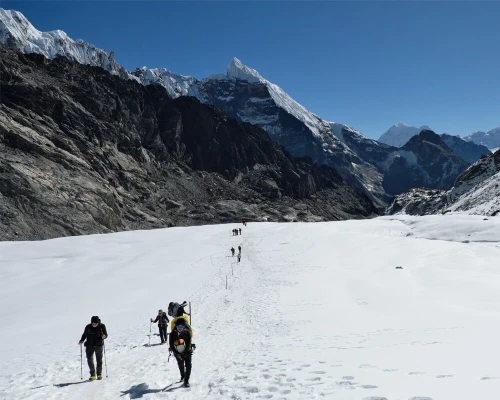
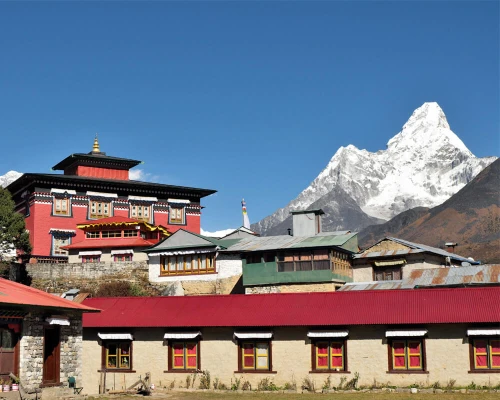
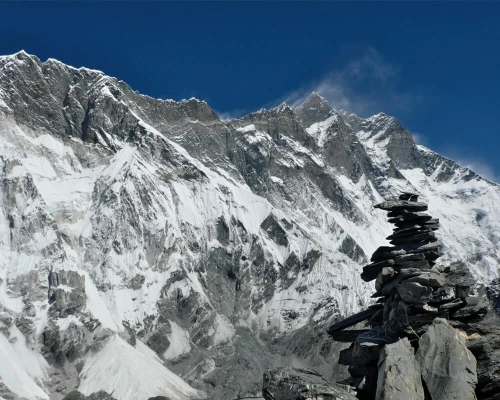
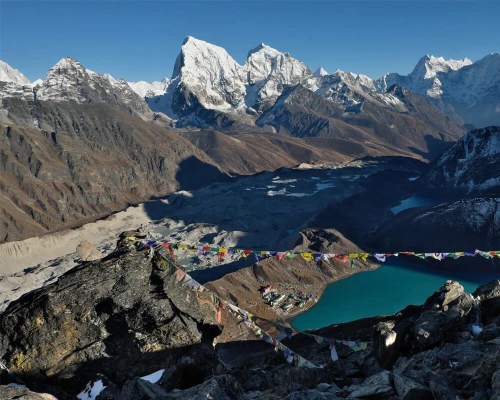
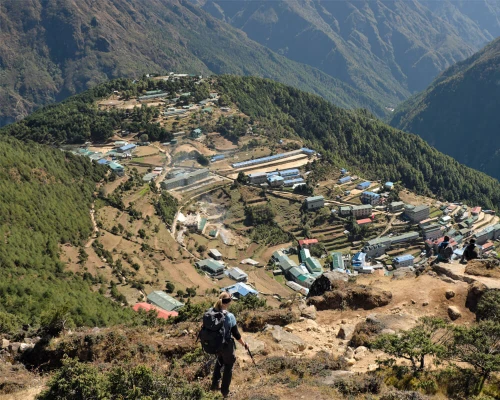
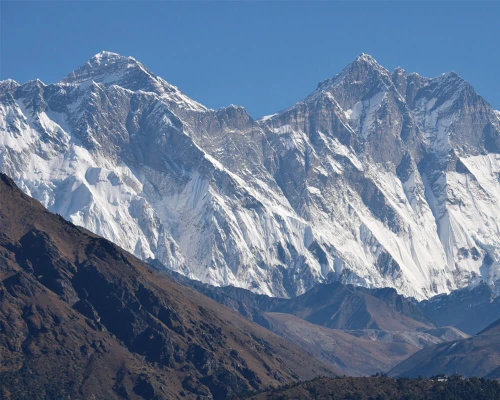
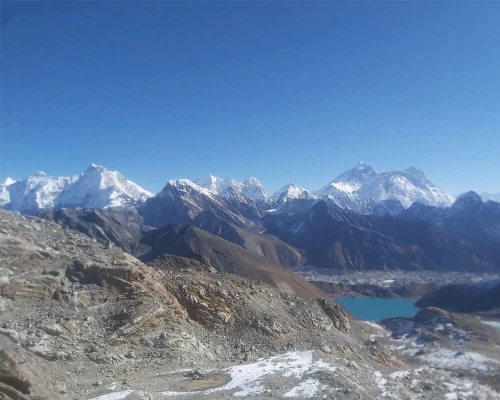

 based on 32 reviews
based on 32 reviews




